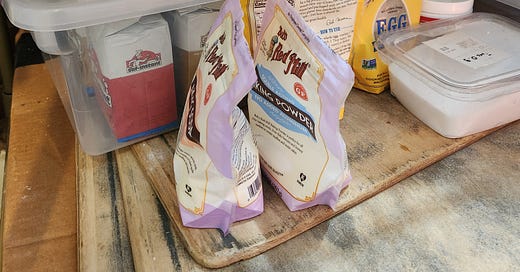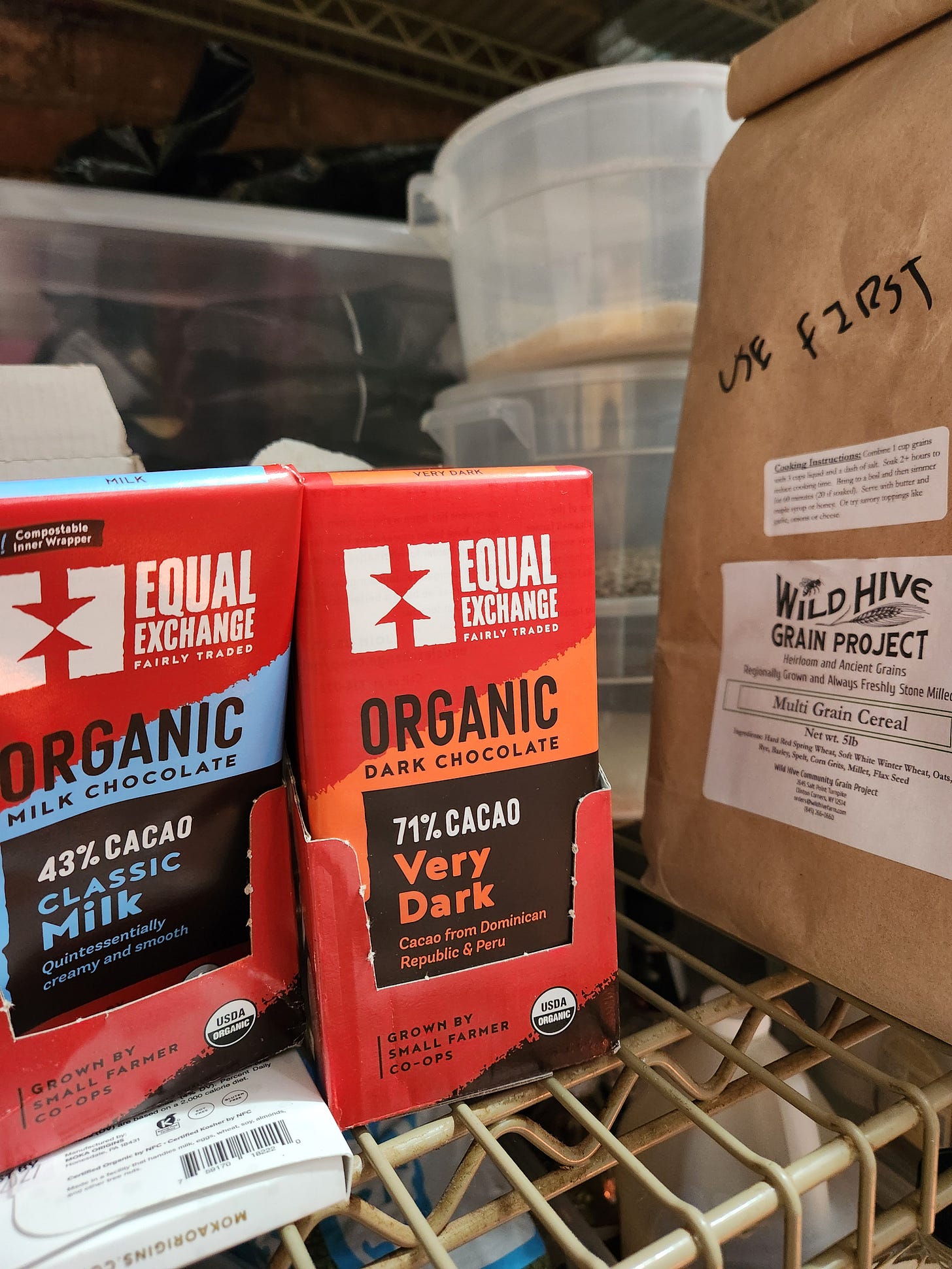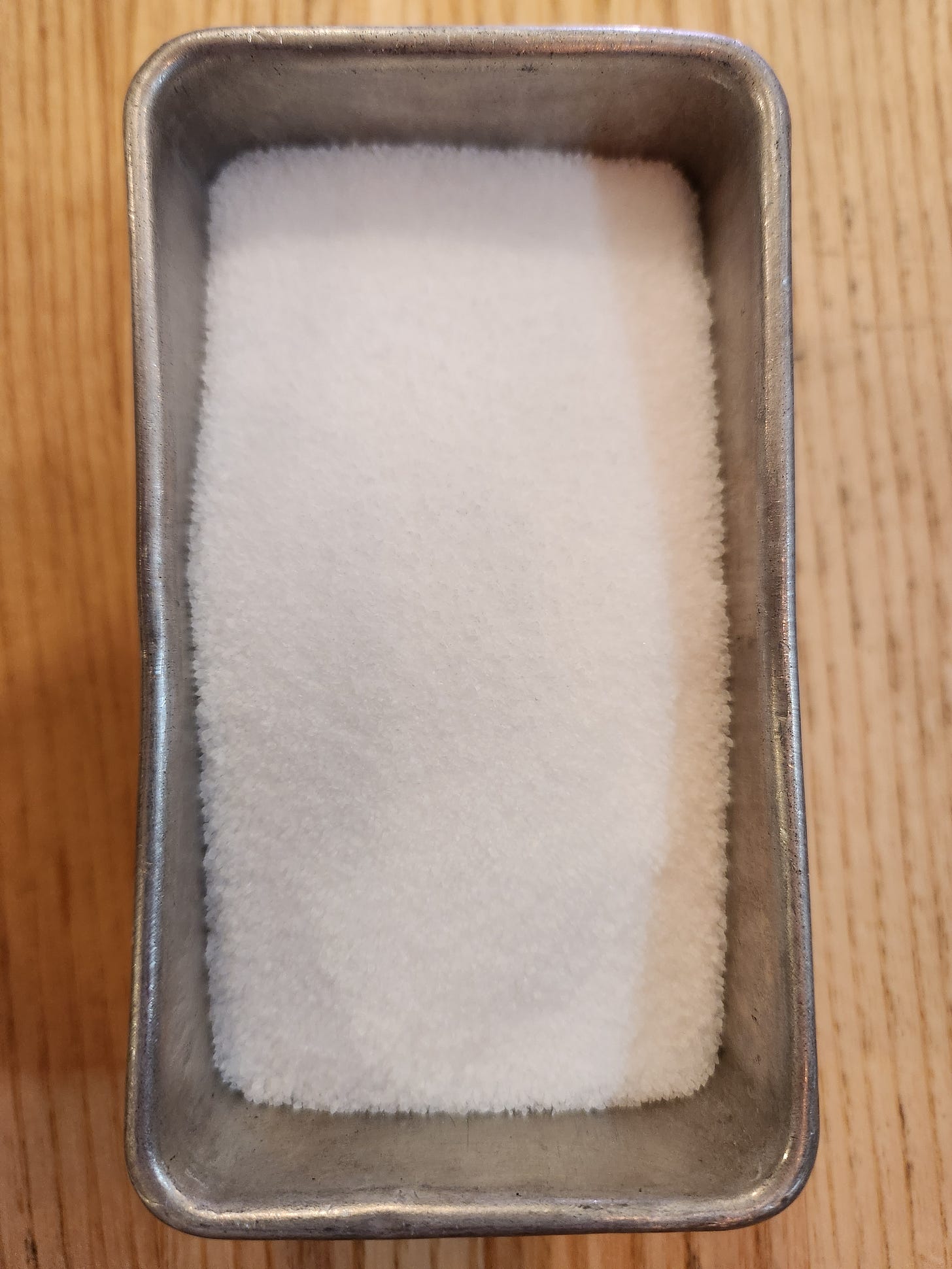Last week we took a deep dive into the equipment you’ll need to be ready to begin baking the full-inclusion way in your home kitchen. This week, we’re moving on to the pantry. Part of the beauty of using weight measurements in your baking is it minimizes many of the discrepancies between different brands and products, meaning you can use just about any ingredients you have on hand for our recipes. So, our list of pantry ingredients is pretty short, as it should be!
Note: we’ll cover vegan baking substitutions in another blog post.
Baking Powder and Baking Soda
At our bakery, we use Bob’s Red Mill baking powder and baking soda. Really, any brand will work in these recipes. Just make sure your baking powder is aluminum-free and double acting, meaning it works twice, once when it is mixed with the liquid in the recipe, and again when it’s exposed to heat from the oven.
Baking soda reacts with acidic ingredients in a recipe. Baking powder is baking soda mixed with cream of tarter, and it can react to itself, even in pH neutral recipes. Baking soda likes to spread out (think of a cookie) whereas baking powder likes to lift up (think of a muffin).
Recipe developers spend a lot of time and do many tests to get the perfect balance of baking soda and baking powder in each recipe. At our bakery, we’re constantly substituting ingredients to make use of whatever fresh, seasonal ingredients are available in our area. In order to be successful doing so, we’re careful to make sure our new ingredient has about the same acidity as the original ingredient the recipe called for. That way, we can be sure the leaveners will do their jobs correctly.
Cocoa Powder and Chocolate
We use natural cocoa powder, not Dutch processed/Alkalized. Dutch processing is a method of treating cocoa powder that makes it less acidic. It also changes the flavor. Both types of cocoa powder are good and have their place. Unfortunately, in pastry recipes, the acidity level of cocoa powder is very important. That’s because the batter needs to have a certain acidity in order for the baking powder and baking soda to react properly. If the leaveners cannot react, not only will the batter not rise properly, but you may also be left with an unpleasant aftertaste in your baked good.
When working with chocolate, you can use pretty much any brand or type of chocolate, as long as the cocoa percentage is similar to what your recipe calls for. Chocolate bars and baking chocolate are designed to melt, but chocolate chips are usually, but not always, made with fats other than the naturally-occurring cocoa butter which allows them to hold their shape in the oven.
Cocoa powder and chocolate are of course made from cocoa beans, which are primarily grown in situations of economic exploitation. Please, try to source fair-trade cocoa powder and chocolate as much as possible. Equal Exchange, Frontier Co-op, Moka Origins, and many other brands offer delicious cocoa powders and chocolates which support the farmers and communities who grew them.
Diastatic Malt Powder
Diastatic malt powder is the only “extra” ingredient we ever add to bread dough. It’s made by sprouting and then drying barley. It contains a naturally occurring enzyme (unlike non-diastatic malt powder, which has had its enzymes inactivated) which helps break down the starches in flour, making them easier for the yeast to digest. In doughs that will ferment for a long time, diastatic malt powder helps ensure there are still some sugars present in the dough when it goes in the oven. If the yeast has eaten all the sugars, the Maillard reaction will not occur, and your bread will never take on that beautiful golden brown color everyone loves. Have you ever baked a loaf of bread for a very long time but found that it’s still pale? Your yeast ate all the sugar!
Malt syrup is simply another form of diastatic malt powder, and it’s commonly added to the water when boiling bagels. It’s sticky and not very pleasant to work with, so if we call for malt in a recipe, unless it’s a recipe for bagels, we’ll call for it in the powder form.
Eggs
We use American large eggs which generally weigh 50 grams (after being cracked) each. Healthy eggs from healthy, happy chickens are best. The best eggs have orange yolks and viscous whites.
Milk
We use whole milk in our recipes. Our milk supplier is Ronnybrook, a family-owned farm in New York. For our recipes, we choose Creamline milk which is unhomogenized and comes in glass bottles. As long as we remember to shake the bottle first, we’ve found that it works just as well as homogenized milk in our recipes, and it’s easier to digest. If you’re not as fortunate as us to have Ronnybrook milk available where you live, any whole milk will do. If you can get milk that was produced locally, not only will your baked goods be more delicious and nutritious, you’ll also be supporting your local dairy farmers.
Note: unhomogenized milk is milk that has not had the fat blended into the milk. It is not the same thing as unpasteurized milk, which we do not use.
Oil
Our default neutral oil is canola oil. You can easily substitute any neutral oil for canola if you’re just not a fan. You could even choose things like olive oil or melted coconut oil; just be aware that those flavors will carry through to your baked good.
Salt
We use fine sea salt which we get in bulk from our local co-op. We like this salt a lot because the small crystal size dissolves quickly and the flavor is perfectly salty and clean. However, you can use any type of salt in these recipes, as long as you measure it by weight. But, note that the teaspoon measurements we list alongside will only be accurate for sea salt, as different types of salt crystals are different sizes.
Spices
There are many great spice companies out there, and a lot of them are doing great things in terms of sustainable, fair-trade sourcing. The company we get the majority of our spices from is Frontier Co-op. Not only are they a cooperative (yay!), but honestly their spices have won and re-won our hearts every time we’ve done a taste-test. We keep their Korintje and Ceylon cinnamons on hand at all times, and we use their Anise seed in our concha recipe and more.
Sugar, Light Brown Sugar, Dark Brown Sugar, and Powdered Sugar
The most basic sugar we use at our bakery is cane sugar which is a bit darker in color and has a slightly larger crystal size than white sugar. The flavor is so much more nuanced and interesting, and it’s also healthier as it’s less processed. We have never had any issues substituting cane sugar for white sugar, although it does take a bit longer for the sugar to dissolve. In recipes where the sugar crystal size needs to be very small, like a sweetened whipped cream, we either use powdered sugar, or we do the ultimate hack: we put the cane sugar in a blender for a minute or two.
Light brown sugar and dark brown sugar are cane sugar that has some molasses added back in. Molasses is, of course, a byproduct of producing sugar. It’s also acidic, which gives the baking soda in many cookie recipes something to react with. Brown sugars can usually be replaced with muscovado, panela, or sucanat, which are sugars that are so unrefined that the molasses was never removed. We use brown sugar in most of our baking because it’s more readily available and usually a good deal cheaper. However, feel free to experiment with other types of sugars in your baking if you wish.
Powdered sugar can be processed to different levels of fineness and usually includes an anti-caking agent. The powdered sugar we use is organic, and many organic powdered sugars use tapioca starch rather than the more traditional corn starch as the anti-caking agent. Organic powdered sugar is also usually vegan, whereas conventional powdered sugar is processed with bone char to whiten it.
For all of these types of sugars, we use the brand Wholesome which has a great selection of organic, fair-trade, minimally-refined sugars.
Vanilla Extract
We make our own vanilla extract using vanilla beans and unflavored vodka. We find this to be the most economical and highest-quality vanilla available. Any type of vanilla extract will work in our recipes.
Yeast, Red and Gold Instant
There are two types of instant yeast, and they’re referred to by the color of the bags they come in: red and gold. Red yeast is the general all-purpose type that we use for all of our starters and many of our final doughs. It can go straight in to the recipe along with the flour, and it will dissolve quickly and get straight to work.
Gold yeast is osmotolerant, meaning that it can function well in doughs that have other ingredients which can interfere with the yeast’s ability to access water. We use gold yeast in so-called enriched doughs which are doughs that contain ingredients like milk, eggs, and butter. Enriched doughs usually have less actual water because they contain several other ingredients that function similarly to water in determining the texture of the dough. Gold yeast should be dissolved in a bit of water or milk before adding it to the dough.
For both red and gold yeast, our preferred brand is Saf.
We’ve always used instant yeast in commercial bread baking, but our full-inclusion journey has only strengthened our love of it. Having excellent yeast provide a perfect lift and crumb for our recipes allows us to really enjoy the textures and flavors of our full-inclusion flours. But, there are other types of yeast out there that it’s important to be aware of.
Active dry yeast is pretty similar to instant yeast, but it needs to be dissolved in water first, and it’s simply not as reliable. However, you can substitute active dry yeast at a one-to-one ratio with instant yeast.
Fresh yeast is sold in small bricks which need to be refrigerated and have a much shorter shelf-life than other types of yeast. Since fresh yeast has a water content, it weighs more than dry yeast. To substitute fresh yeast, you’ll need about three times the weight of dry yeast that the recipe calls for. Some bakers swear by fresh yeast because they prefer the flavor of it in their breads. To us, the flavor seems a bit overpowering honestly, and not at all worth the effort. But, it's a fun thing to try at least once in your life, and if you get your hands on some, give it a shot!
This week’s recipe is for Oat Crumble and Jam Coffee Cake, a favorite spring bake of ours. It uses many pantry staples, including jam which brings the fresh flavors of the season, even before the first berries reach the market. Let’s get baking!






